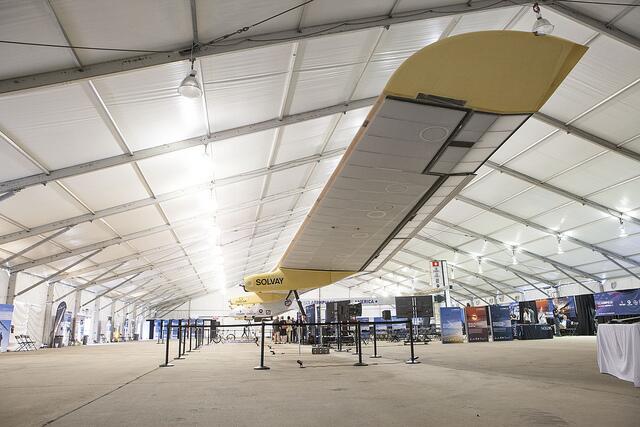SOLAR POWERED AIRPLANE LANDS IN DC -- WHAT CAN'T WE DO WITH SOLAR? Green Energy Blog, June 17, 2013
Solar Impulse, the Swiss-made, solar-powered airplane, completed the fourth leg of its transcontinental flight at 12:15 a.m. Sunday when it touched down at Dulles Airport, outside Washington, D.C.
The plane’s journey across the U.S. began May 3 in San Francisco, with stops in Phoenix, Dallas, St. Louis, and a last-minute pit stop Friday in Cincinnati. After a two-week stay in D.C., it is scheduled to fly the last leg of the trip to New York City.
The plane and its pilots have become celebrities along the way, with airports and the Federal Aviation Administration working with them to make the flight possible.
There are lots of pictures, videos and insightful blog posts on the Solar Impulse website. Here’s the plane taking off from Cincinnati. (Yes, the pictures, from the Solar Impulse website, are oversized, but they’re so cool, I wanted to get them in here.) The day started with fog, and the plane’s trademark dragonfly wings with solar panels embedded had to be carefully dried.
And here it is, landing in D.C., at one of the project leaders and pilots, André Borschberg, waits on the runway. The plane, which travels at about 50 miles per hour, has made night-time landings across the country so it could avoid major daytime air traffic.
Beyond the sheer adventure, what has been important about the flight is that it has shown that solar power can be stored and used in the dark.
After a public open house at the Smithsonian National Air and Space Museum Sunday afternoon, Borschberg and co-pilot Bertrand Piccard on Monday received the 2013 Innovator of the Year Award from the Solar Energy Industries Association. You can see some pictures from the event – with Energy Secretary Ernest Moniz in attendance – on the Solar Impulse twitter feed @solarimpulse. I’ve also retweeted a few @kkaufmann.
Here’s the plane on display before the event (slightly smaller image than the others, yay!). Gotta love those wings!

The point of the flight, as Borschberg and Piccard have said repeatedly, is to show the possibilities of solar power.
“If we can make a solar airplane fly day and night without fuel, can you imagine how many other incredible things we could do in
this world with solar energy?” they said at the award ceremony at the Air and Space Museum.
this world with solar energy?” they said at the award ceremony at the Air and Space Museum.
Bertrand Piccard (left) and Andre Borschberg (right) receive the Innovator of the Year Award from Rhone Resch, president and CEO of the Solar Energy Industries Association Monday at the National Air and Space Museum.
Speaking of which, the solar industry in the U.S. had its best first quarter ever this year, according to a market update released June 11 by the SEIA and Greentech Media.
Across the country, 723 megawatts of solar power were installed, 33 perecent more than Q1 2012 and more than 48 percent of all new generation in the U.S. from January through March. All told, the U.S. now has 7,962 megawatts of solar. GreenTech Media is predicting a rooftop revolution in the next four years.
“Whereas residential and commercial solar markets have historically been effectively capped by the availability of state- and utility-level incentives, solar has now become cost-effective in some markets with only the federal investment tax credit (ITC), accelerated depreciation and net metering.”
California remains the leader in solar installations, rooftop and utility scale. The state added 408 megawatts of solar installations in the first quarter this year, about 40 percent of our total 1,045 megawatts for all of 2012.
In the meantime, the Solar Impulse team now begins preparations for its next challenge, an around-the-world flight in 2015. I’m betting they’ll make it.
NEXT ARTICLE
Share your thoughts
Powered by Facebook Comments
No comments:
Post a Comment